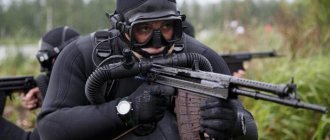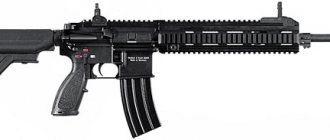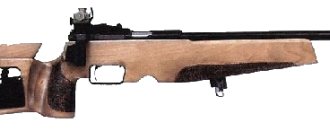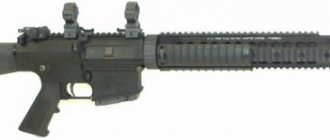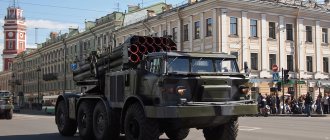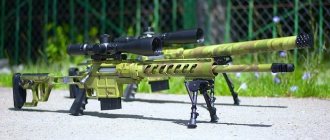Of all types of winter sports, two are most often distinguished as the most spectacular. This is hockey and biathlon. The USSR, and then Russia, have always been proud of their merits and achievements in these sports. Take, for example, Kharlamov in hockey or Tikhonov (four-time Olympic champion) in biathlon. Everything is clear with a hockey player’s equipment - skates, stick, helmet. With biathlon, everything is much more interesting and attractive, since in fact it is a double sport - skiing and shooting. Regarding equipment for movement, everything is also clear: the main thing is to guess the lubricant according to the weather, but with a biathlete’s weapon, which is a rifle, everything is not so simple. The participant will have a difficult choice regarding the brand, since the result of successful shooting depends on this. Therefore, experienced athletes carefully select weapons. What does a biathlon rifle look like? Her photos will be presented to the reader later in the article. In the meantime, let’s take a short excursion into history and find out when and under what circumstances this type of sporting weapon appeared.
A little history
At the end of the Second World War, the most popular competitions were military patrols; in essence, this was the prototype of modern biathlon. The equipment at that time was an ordinary Mosin army combat rifle, which also included a bayonet. By the way, they were also in service with the Soviet army during the war with Germany.
After much debate by the International Olympic Committee, the long-awaited debut of biathletes at the Winter Olympics took place in 1960. For Soviet athletes, the Izhevsk Machine-Building Plant produced the Biathlon-59 rifle in pilot production. The sight of a biathlon rifle at that time was diopter. It was also equipped with carrying straps and a special protective case. The weight of a biathlon rifle was not strictly regulated at that time.
BIATHLON CLOTHING
Clothing in biathlon Clothing in biathlon is crucial for achieving a good result, so biathletes choose equipment with special care. The ski suit is made of thick fabric and fastens either at the back or at the chest.
At high speeds, and in biathlon they reach up to 80 kilometers per hour, the main function of a good suit is to reduce air resistance (flow) and keep the athlete warm during the race. It is also worth choosing carefully when choosing shoes; they are necessary to reduce the stress on the ankles of the feet while running, and therefore they are usually selected as hard ones.
As for the rest of the paraphernalia, glasses, a cap or a bandage, maybe a visor? It all depends on the individual preferences of each athlete. The main thing, I would like to point out as a mandatory condition, is the presence of gloves with the ability to “reach” the index finger without removing it.
More detailed information can be obtained from the section HOW TO CHOOSE SKI EQUIPMENT?
We recommend watching the video “Training of Biathletes.”
Course for modernization and improvement
After the 1960 Winter Olympics, weapons designer Sherstyakov, using the Mosin rifle as a basis, produced a new weapon for biathlon. The resulting sample was produced in two versions and had names depending on the caliber: “Biathlon Bi-7.62” and “Biathlon Bi-6.5” (their cartridges had dimensions of 7.62 mm and 6.5 mm respectively).
The use of this particular weapon brought Soviet biathletes their first Olympic successes, in particular, Vladimir Melanin was able to win the first gold medal in biathlon in 1964 at the Winter Olympics in Innsbruck.
In the early seventies, the production of the new Biathlon Bi-4 rifle began, which was fired with rimfire cartridges. The model had significantly less weight. The next new product was released just a year after the release of the previous one and was called “Biathlon Bi-5”. The shooting was carried out with central firing cartridges of 5.6 mm caliber. It was with this rifle that the victorious golden march of four-time Olympic champion Alexander Tikhonov began.
Requirements for a biathlon rifle
The regulations of sports competitions impose a number of serious requirements on a biathlon rifle.
The weight of the weapon should not be less than 3.5 kg. Standard caliber is 5.6 mm. The transition to small-caliber weapons occurred in 1977; Before that, biathletes used rifles with a caliber of 7.62 mm. The changes were brought about by the need to ensure safety when handling weapons. The introduction of a rifle with a reduced caliber led to a change in the shooting distance. The athletes had to adapt to new conditions. The smaller caliber reduced the recoil when firing a shot. However, the influence of wind on the accuracy of hits has increased. Safety requirements were tightened: the rifle had to be securely fastened behind the athlete’s back; During shooting, the biathlete was not allowed to leave the special rubber mat. Violation of strict rules resulted in punishment, including disqualification.
According to accepted standards, a rifle for biathlon shooting must be equipped with a 5-round magazine. There is also space for attaching three additional ammunition - they are allowed to be used if the main cartridge turns out to be faulty, as well as in case of misses during relay races.
Athletes who compete at the highest levels use weapons specifically tailored for them. Each part of the rifle is made taking into account the anatomical features of the athlete. Particular attention is paid to the ease of placing the rifle against the cheek. At the same time, designers have to take into account the general requirements for weapons from the regulations, because before each race, special judges meticulously check all the equipment of biathletes.
Even the most reliable and proven rifle can fail. If you fall, the belt may break, and it is possible that the weapon may fail if you use a low-quality cartridge. During the race, the athlete pays utmost importance to the safety of the weapon: biathletes are even taught to fall “correctly” in order to protect the rifle from damage to the maximum extent.
Weapons of competitors
Not only in the Soviet Union they knew how to make weapons for biathlon. Foreign manufacturers should also be noted. The most famous are “Walter” from Germany, “Sako” of Finnish production and the Austrian “Stayer Mannlicher”.
The most famous and promoted biathlon rifles are “Anschutz”. It was to the management of this company that the German army biathlon team approached with a request to develop a rifle for biathlon, which would completely suit German athletes according to such criteria as convenience and recoil force. Thus, to create a new weapon, they used the best small-caliber rifle, which at that time was the Antschutz-54, improving it for a low-pulse central ignition cartridge of .222 caliber.
Which rifle should an amateur biathlete choose?
Here's what you need to do to turn MP series samples into biathlon ones:
It is important to understand that such rifles are not intended for biathlon; even with modifications, they are significantly inferior in rate of fire to specialized models.
Changing priorities
1978 is considered an important milestone in the development of biathlon. The transition to small-caliber weapons made this sport accessible and widespread. And the initiator of this significant event was the same German company, which, by order of its compatriots, designed such a weapon. Countries whose athletes were the best in this sport, namely the USSR, Norway, Finland and the USA, did not want to lose their positions in world biathlon and switch from military weapons to small-caliber ones.
Therefore, at the vote that was held with the aim of switching to a new caliber, there were not particularly ardent supporters of the new weapon. And then “political blackmail” was carried out by the Austrian side, which refused to hold the Biathlon World Championships in 1978 if the new weapon was not adopted. Three voters changed their original decision, and the scales tipped in favor of the new model.
Thus, the German manufacturer and athletes have become leaders in world biathlon, each in their own field. A unique standard for sporting weapons has been formed: the weight must be at least 3.5 kg, the caliber of a biathlon rifle must be 5.6 mm, better known as .22lr. The cartridges must be rimfire.
The consequence of the transition to small-caliber weapons was a decrease in the distance to the target - now it was 50 m. German biathletes won seven of the nine gold medals at the Biathlon World Championships in 1978, held under the new rules. The head coach of the USSR national team, Alexander Privalov, a former medalist of two Olympic Games, blamed the disastrous performance of the USSR national team not on a change in weapons, but on a new type of ski used and incorrectly selected lubricant.
An adequate response to rule changes
Gunsmiths and designers at Izhmash (Izhevsk Machine-Building Plant) urgently presented a new Biathlon Bi-6 rifle, using rimfire cartridges, in accordance with the new requirements.
The secret of such a rapid release of new weapons is explained quite trivially: just as in the early 60s, using the basis of the Mosin rifle, the Biathlon Bi-7.62 and Biathlon Bi-6.5 samples were developed, so in this time the designers took the ready-made versions of “Ural-5-1” and “Ural-6-1” and, through deep modernization, created the “Biathlon Bi-6”.
Rifle device
The biathlon air rifle is approximately the same for all manufacturers and differs only in the design of the components and some individual positions. In any case, all differences are regulated and strictly controlled. A biathlon rifle, the device of which consists of standard components and mechanisms, has a barrel, a wooden stock, a bolt, a trigger mechanism, a sight and a magazine. The design of the butt allows, if necessary, to change its linear dimensions by installing additional spacers. A biathlon rifle sling is also required. Only the shoulder version is used, as this is the most practical option. The sight of a biathlon rifle must only be dioptric; the use of an optical one is prohibited.
You can individually adjust and fit other parts of the rifle, for example, the “cheek” (the upper part of the butt) and the belt, which has a hook for the swivel. The position of the weapon's center of mass can be adjusted by adding or decreasing balance weights. Quick reloading of the rifle, without changing the position of the athlete, is carried out using a crank mechanism, which locks the barrel bore using vertical axes of rotation.
Protective covers perform their function of protecting the barrel channel, weapon sight and front sight from various types of contamination. The design of the trigger mechanism allows you to optimally adjust the pressing force, the travel of the trigger, as well as the nature of the release without disassembling the weapon. From the very beginning of biathlon, its rules stipulated that only a sliding bolt of a biathlon rifle was allowed, and only after the events of 1978 were they allowed to use models with a different design of this mechanism.
Shutter design
Each company that produces sporting rifles develops and produces weapons with its own bolt design. The German company uses a shutter whose design was developed back in 1935, constantly improving it.
Until 1984, all weapons of this brand were produced using a design with a rotating mechanism. After 1984, gunsmith P. Fortner installed a bolt action on the rifle without warning, and this design is used on all models to this day. A distinctive feature of these devices is their more compact size and the absence of lugs required for powerful cartridges.
Reloading the rifle is done very simply, with two fingers: by pulling the handle with your index finger, the bolt is cocked, and its reverse action is carried out by pressing the back of the mechanism with your thumb. Also, the reliability of the weapon during reloading is influenced by the ejector and extractor, which, due to their design, reliably perform their functions at low air temperatures.
Other valve designs
The Finns first used a new shutter design in their Finnbiathlon model, produced by Tampeeren Asepaja. The mechanism had a longitudinally sliding stroke and did not need to be turned.
Following them, the Bi-7 biathlon rifle also appeared in the Soviet Union, the bolt of which has the same design. It is impossible not to note the merits of the outstanding weapons designer Susloparov. In a short time, he was able to prepare the Bi-7-2 prototype for the Olympic Games in Moscow, which continued the development of sports weapons of the most famous Biathlon series. Speaking at the Olympics with a new model, the already well-known Alexander Tikhonov won his fourth Olympic gold medal in the relay. By the way, at the next two Winter Olympics, biathletes from the Soviet Union used this particular rifle to take gold in the relay race.
Development of Biathlon series rifles
Based on the most famous rifle “Bi-7-2”, in the early 90s the “Bi-7-3” and “Bi-7-4” models were developed and adopted by biathletes. The life cycle of these brands, with constant improvements, will last until the Winter Olympic Games in Vancouver.
Since 1991, the main supplier of weapons for biathletes, the Izhevsk Machine-Building Plant, began production of the new Bi-7-2 model. The biathlon rifle in this series is fired with .22lr rimfire cartridges, according to the standards generally accepted in 1978. Feeding occurs from removable magazines, the capacity of which is designed for five rounds. Also included in the standard kit are devices for additional ammunition, in the amount of three pieces. During the race, four magazines are located in a special cassette, which is attached to the butt of the rifle.
The barrel channel of this pneumatic is locked using a hinge-lever design.
The main criterion for shooting in biathlon is the rapid reloading of the weapon without changing the position of the biathlete and wasting precious time on new aiming. The cartridge is fed into the barrel of the Bi-7-2 rifle using a reciprocating motion thanks to a special handle. The shutter moves in a small arc during reloading.
The rifle is balanced, which is adjusted by adding or removing correction weights. Trigger force and trigger stroke can also be adjusted. The cheek piece on the butt and its length are adjustable and customized individually for each athlete, since accuracy depends on the athlete’s comfort when shooting. The barrel, front sight and sight of the rifle are equipped with special quick-hinged covers, the main function of which is to protect the weapon from snow, dirt and other contaminants that can affect shooting accuracy.
As already mentioned, the production of this brand of rifle has been going on for a long time, and throughout this time it has been subject to improvements and modernization. For example, today they produce the Bi-7-4A model. The letter A in the name indicates that this rifle is equipped with a well-known German barrel.
What do biathletes shoot and whose rifle is in reserve? Unobvious facts about cartridges and weapons
However, in biathlon, even elite, choosing a cartridge is a whole epic, and you can’t just buy, for example, a Lapua and be sure that it will fit your rifle. Moreover, you cannot be fooled by marketing promises that new cartridges will be better than previous ones. So, when Lapua produced cartridges in Finland, their quality, according to Andrei Gerbulov, Shipulin’s shooting coach, was higher than after the transfer of production to Germany.
Selection of cartridge
The “barrel + cartridge” complex is responsible for shooting accuracy. Moreover, in this case, the term “cartridge” is not only a brand and brand, but also a series. The performance of the same brand of cartridges varies from series to series, so each new series has to be shot again.
The main problem is that the series is finite, since it is determined primarily by the supply of lead slabs for bullets. When the lead from a given slab runs out, the series ends. It will not be possible to repeat it or make it to special order. We need to shoot a new one.
Usually, at the end of the season, shooting specialists shoot all the barrels of the team with new series of cartridges from the main manufacturers. There is a certain pattern here: Olympus is better suited for Izhmash products, and Lapua is better suited for Anschutz. This is explained by the fact that “Olympus” was originally created for domestic rifles and the lead of the bullet is softer in order to fill the rifling in the barrel, preventing breakthrough of powder gases when fired. Accordingly, in the spring, specialists take new series of cartridges from the brand that, as a rule (but not always), is better suited to the barrels of a given manufacturer, and begin to shoot them.
Elite rifles
Elite ones include samples made to order for a specific athlete. The Bi-7-4 rifle in its ninth modification has a completely new stock, the settings of which can satisfy the requirements of any biathlete; a new diopter sight from a competitor; ring front sight, which can be adjusted. To protect against corrosion and improve performance, the receiver and barrel are chrome-plated. Among other models of elite rifles, the Antschutz 1827 stands out, which is called “the best of the best” by many champions and biathletes.
Domestic rifle BI 7-4
Air rifle BI 7-4
Removable magazines are designed for five charges. They are installed on the butt - for this purpose there is a cassette for four magazines. In addition, the kit includes additional magazines with a cover, designed for three charges. For balancing, special weights are used that can be easily removed. The original shoulder strap has comfortable spring elements.
You can buy a rifle from 80 to 120 thousand rubles (depending on the version).
Shutter operation diagram
When reloading, the shooter moves the handle, causing the bolt to move in an arc. To lock the barrel channel, a crank-type hinge-lever scheme is used. These are two elements, the connection between which is carried out using a hinge. The front part of the first part is on the same axis with the bolt, and the rear part of the second part is on the same axis with the receiver.
When the bolt reaches the forward position, the hinge reaches the “dead point”, going beyond it. It rests against the barrel box, and the bolt cannot be opened so easily. To open it, the shooter pulls the handle back, as a result of which the hinge comes out of the “dead zone”, and the parts of the locking unit fold, moving the bolt back.
Air rifles presented by the Izhevsk Mechanical Plant are distinguished by extreme reliability and the longest possible service life. The price of the IZH 38 air rifle is indicated in this article, as well as other features of this rifle. How much you can buy a Moran air rifle can be found on this page. Technical characteristics of this rifle and its features.
